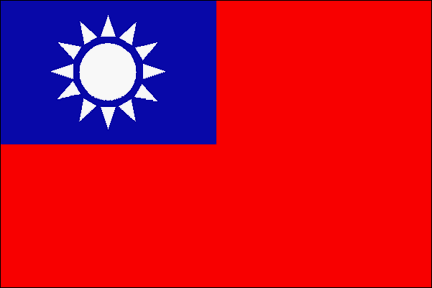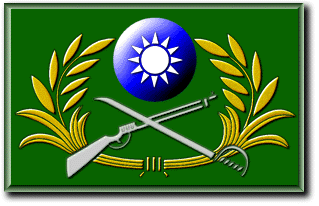





 Ground forces in the ROC, mainly those of the Army and the Military Police, number nearly 270,000. Taipei's approximate 220,000-member Army is organized and trained to defend Taiwan and the offshore islands against an invasion. About 80 percent of the Army's combat strength is on Taiwan proper, under the control of three field armies. The three offshore island commands -- Chinmen, Matsu, and Penghu -- have a total of more than 50,000 soldiers.
There are as many as 1,500,000 reserve troops whose obligation of service extends until the age of 30 years. The government has set a policy "to reduce the number of regular forces and increase that of the reservists," with the intent to achieve the objective of "retaining fewer soldiers in peace time and mobilizing more forces at wartime." In 1997, the registered reservists of this country amount to more than 3,870,000 persons with 3,060,000 assigned to the Army, 450,000 assigned to the Navy, and 360,000 assigned to the Air Force, which is 18% of the total population. Within the Reserves there are over 310,000 officers, 1,371,000 NCOs, and 2,189,000 enlisted personnel.
Ground forces in the ROC, mainly those of the Army and the Military Police, number nearly 270,000. Taipei's approximate 220,000-member Army is organized and trained to defend Taiwan and the offshore islands against an invasion. About 80 percent of the Army's combat strength is on Taiwan proper, under the control of three field armies. The three offshore island commands -- Chinmen, Matsu, and Penghu -- have a total of more than 50,000 soldiers.
There are as many as 1,500,000 reserve troops whose obligation of service extends until the age of 30 years. The government has set a policy "to reduce the number of regular forces and increase that of the reservists," with the intent to achieve the objective of "retaining fewer soldiers in peace time and mobilizing more forces at wartime." In 1997, the registered reservists of this country amount to more than 3,870,000 persons with 3,060,000 assigned to the Army, 450,000 assigned to the Navy, and 360,000 assigned to the Air Force, which is 18% of the total population. Within the Reserves there are over 310,000 officers, 1,371,000 NCOs, and 2,189,000 enlisted personnel.
Educational recall aims at intensifying the mobilization combat readiness and upgrading military skills and capabilities to perform their operations missions. In 1996 and 1997, about 200,000 reservists received educational recall and training with a duration from 5 to 7 days for training on subjects including firearms training, tactical force structure, and the combat readiness tasks. According to the annual mobilization program, all reservists, except those who have already been listed in educational recall, are called up each year in order to maintain readiness and update personal data. Since 1996 the one day (8 hours) muster recall has been reduced to a two-hour recall.
In 1997, the Army began an ambitious restructuring campaign to upgrade its combat effectiveness, emphasizing rapid reaction capabilities, airborne invasion interdiction, and special forces operations. The most extensive force restructuring since 1949, Project JingShi ("Solid Yet Elite") entails significant down-sizing and rationalizations. Taiwan's Ministry of Defense plans an approximately 10% reduction in personnel (from 450,000 to 400,000) by 2001-2003, with bulk of the cuts coming from Army and Marine Corps. Most of the cuts are occurring in the Army, which will number about 200,000. There will also be a dramatic reduction in the ranks of general officers, from about 700 to around 400. The three existing field armies will remain intact; however, the Army will eliminate divisions as operational units in peacetime. Existing infantry and mechanized divisions will be reorganized into specialized combined arms brigades. The primary reason for this reduction is to create a smaller army with more mobility and firepower. Another reason is the military's competitive disadvantage in recruiting and retaining highly-trained and technologically proficient personnel to handle modern weapon systems. In August 1998 the General Staff authorized a general stand-down in operating tempo for all units involved in reorganziation, consolidation or rationalization dictated by the JingShi master plan. The ROC Army was directed to maintain at high readiness only the minimum garrison levels necessary for responding to local contingencies.
With the recent devaluation of Taiwan's currency, which lost 20% of its purchasing power, the individual service branches are reassessing their major foreign procurement programs timing and priority.
The Army is currently organized into combat, combat support, and service support troops-all under the command of the Army GHQ, and is organized into the following units:
The Army General Headquarters is responsible for developing and maintaining the Army's combat power, commanding and supervising all subordinate troops and units. Under its command are the Army Logistics Command , Army Commands , and the Airborne and Special Operations Command . Also under its command are the various Army units (in descending order) of army, division, brigade, battalion, company, and platoon.
The Army General Headquarters is the component which takes responsibility for issuing directives and conducting training. When the GHQ was established in the winter of 1943, at the height of the War of Resistance against Japan, it was called the Military Affairs Committee.It was founded to meet the needs of the resistance coalition and to restrain the spread of Japanese influence on the Mainland and in eastern and southern Asia. Its main branch, located in Kunming, assumed responsibility for coordinating directives and training for the western and southern battle districts. After the defeat of the Japanese, the Military Affairs Committee was converted into the Ministry of Defense, and assumed responsibility for running the army, navy, air force and logistics headquarters. The army GHQ was recomposed of the Military Affairs Committee's training division and troop supervisory personnel and selected personnel from the Public Division located at Shuichin, Hsuchou. This new establishment included the GHQ, divisions one through six, and special work groups for official business, military machinery and medical care.In October of 1949, as the situation on the Mainland fell into chaos, the GHQ was attacked by the communist forces. A small number of personnel were able to board planes and head for Taiwan. A second group of personnel travelled to Taiwan via Vietnam, while those remaining dispersed. At this point, the GHQ ceased to exist. On March 1, 1950, Chiang Kai-shek resumed the Presidency. He was determined to reconsolidate the military and implement counter-attack preparations. That same month, the Ministry of Defense was reorganized, and it was decided to reinstate the army GHQ. On April 16, the GHQ, a reconfiguration of the Taiwan Defense Headquarters,was intalled at Fengshan. In September of 1950, the GHQ was relocated to Taipei, where it remained until the Northern Anchor exercises of 1976.
Presently, the GHQ is in Taoyuan. Since its establishment in 1943, the GHQ has passed through the War of Resistance, resisted the communists and undergone a number of important changes in Taiwan. Its functions have been tp provide comprehensive directives to troops, and to draft and implement military plans.
The Chinese Military Academy (CMA), founded by Dr. Sun Yat-sen in 1924 at Whampoa, Kwangtung Province, relocated to Fengshan , Kaohsiung County, Taiwan in 1950. The large campus features modern educational facilities and equipment to cultivate future army officers and develop military science. The CMA has a tradition of stringent educational requirements, accepting and training only the most qualified candidates. In 1954, the CMA began placing increased emphasis on education in scientific, technical, and other non-military fields. Cadets are required to complete 130 university-level credits in subjects such as political science, social science, mathematics, physics, chemistry, mechanics, civil engineering, electrical engineering, information management, and foreign languages over a period of four years. Right after graduation, the young lieutenants receive further training in a branch specialty, such as infantry, armor, artillery (missiles), engineering, transportation, communications (electronics), chemistry, or the military police.